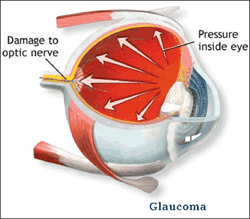Glaucoma
Glaucoma
Glaucoma is a group of eye diseases that gradually steal sight without warning. In the early stages of the disease, there may be no symptoms. Vision loss is caused by damage to the optic nerve. This nerve acts like an electric cable with over a million wires. It is responsible for carrying images from the eye to the brain.
There is no cure for glaucoma—yet. However, medication or surgery can slow or prevent further vision loss. The appropriate treatment depends upon the type of glaucoma among other factors. Early detection is vital to stopping the progress of the disease.
It was once thought that high pressure within the eye, also known as intraocular pressure or IOP, is the main cause of this optic nerve damage. Although IOP is clearly a risk factor, we now know that other factors must also be involved because even people with “normal” levels of pressure can experience vision loss from glaucoma.
In the United States, the most common form of glaucoma is open angle. Open angle glaucoma occurs when the eye’s drainage canals become clogged over time. The inner eye pressure (also called intraocular pressure or IOP) rises because the correct amount of fluid can’t drain out of the eye. With open angle glaucoma, the entrances to the drainage canals are clear and should be working correctly. The clogging problem occurs further inside the drainage canals, similar to a clogged pipe below the drain in a sink.
Most people have no symptoms and no early warning signs. If open angle glaucoma is not diagnosed and treated, it can cause a gradual loss of vision. This type of glaucoma develops slowly and sometimes without noticeable sight loss for many years. It usually responds well to medication, especially if caught early and treated.

Detecting Glaucoma
Early detection, through regular and complete eye exams, is the key to protecting your vision from damage caused by glaucoma. Regular check-ups include two routine eye tests: tonometry and ophthalmoscopy.
Tonometry – The tonometry test measures the inner pressure of the eye. Usually drops are used to numb the eye. Then the doctor or technician will use a special device that measures the eye’s pressure.
Ophthalmoscopy – Ophthalmoscopy is used to examine the inside of the eye, especially the optic nerve. In a darkened room, the doctor will magnify your eye by using an ophthalmoscope (an instrument with a small light on the end). This helps the doctor look at the shape and color of the optic nerve.
Glaucoma testing is warranted if:
- The pressure in the eye is not in the normal range
- The optic nerve looks unusual
- The patient has other risk factors for glaucoma
- There are four types of glaucoma tests
- perimetry (visual field test)
- gonioscopy (measuring the angle where the iris meets the cornea)
- pachymetry (tests corneal thickness)
- optic nerve computer imaging (measures thickness of nerve fiber layer)

Who can develop glaucoma?
Unfortunately, anyone can develop glaucoma, although certain people may be more at risk than others. Scientific study indicates that anyone over the age of 60, people of African and Asian descent over the age of 40, and anyone with a family history of glaucoma are the most likely to develop this condition. Whether or not you are in one of these groups, regular testing for glaucoma can only help.
What is the treatment?
If you have been diagnosed with glaucoma you should know that it is treated using a variety of methods. In the early stages, eye pressure can usually be controlled by medications that either reduce the amount of fluid produced/delivered to the eye or by aiding in fluid drainage. If we feel that these drugs are not effective for you, we may recommend laser surgery. This is a procedure that is performed in the office and is aimed at increasing the size of your eye’s natural drainage holes to help reduce fluid build up. Another surgical method for treating glaucoma creates an additional hole for drainage rather than enlarging the holes you already have.

Can you recover from glaucoma?
Despite the many advances in eye healthcare over the years, the sad fact is that glaucoma can only be controlled, not cured or reversed. Vision lost due to glaucoma cannot be regained. For these reasons it is critical that you and your family be tested for the condition at regular intervals.
~Photos courtesy of National Eye Institute, National Institutes of Health
Many facts found at Glaucoma.org
Our Location
Chicago Glaucoma Consultants - CGC Eye Center, Glenview, IL
Phone (appointments): 847-510-6000
Phone (general inquiries): 847-510-6000
Address: 2640 Patriot Blvd., Suite 100, Glenview, IL 60026
Glenview Hours
Monday: 7:30 am - 5:00 pm
Tuesday: 7:30 am - 5:00 pm
Wednesday: 7:30 am - 5:00 pm
Thursday: 7:30 am - 5:00 pm
Friday: 7:30 am - 5:00 pm
Saturday: Select Saturdays only
Sunday: Closed

